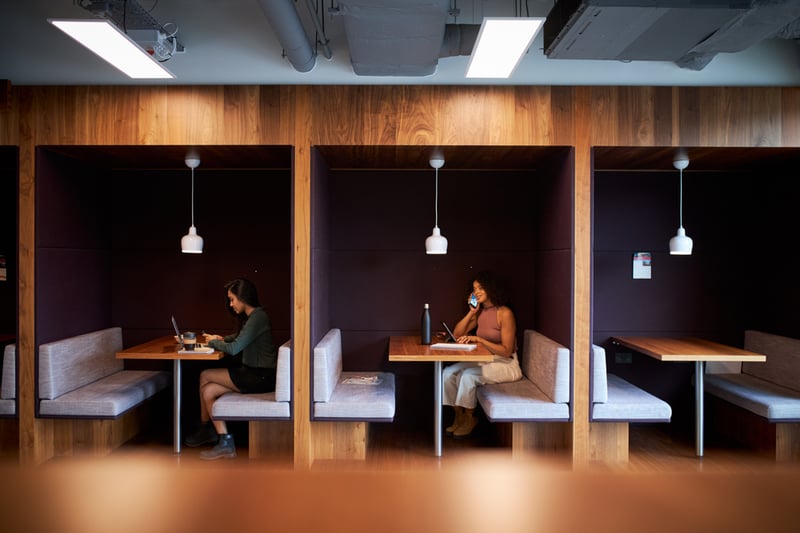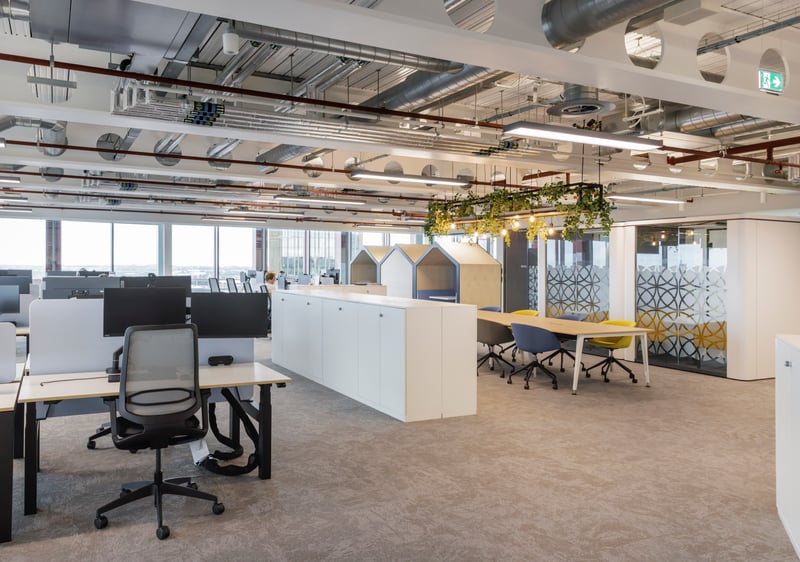According to the Gensler 2023 report on UK Workplaces, the number of hours spent by UK employees in the office has halved since 2016. However, the majority of the UK office workers interviewed also admitted that spending two-thirds of their work week in the office, or 75% of their work hours for employees in innovative sectors, would maximise their team and individual productivity. With employees spending less than their recommended hours for productivity in the office post-pandemic, there is a great need to implement solutions that will not only maximise their productivity, but also encourage employees to spend more hybrid hours in the office.
Flexibility in Choice
Commercial occupiers and architects are tasked with the challenge of reworking the workplace design to address a balance of flexibility and productivity. Having different furniture typologies starting from single to multiple-person seating and providing ergonomic furniture such as height-adjustable desks all play an important role in boosting productivity and workplace experience.

Bringing a sense of comfort and flexibility in choice to the office space can encourage employees back to the office. Employees need a choice of how to work and where to work more productively, which may vary each day. The Gensler report reveals that approximately 84% of the UK workforce with high workplace effectiveness and experience have workspace options within the office.
The report additionally showed that a diverse mix of individual workspaces, creative collaborative settings, rest spaces, phone rooms, and outdoor spaces could highly impact employee experience and workplace effectiveness by over 10%. A project we are currently working on incorporates several lounges, individual workspaces and breakout spaces.
Adaptability of Spaces
With everyone currently taking phone calls and virtual meetings in the office, the typical large meeting rooms must be adapted and reworked into cellular flexible spaces and pods that would allow a large task force to hold different virtual meetings at a time. Instead of taking up a whole meeting room space for just a single person’s team call, individual cellular units provide more efficient use of space, adequate privacy and acoustic comfort.

For commercial occupiers, the adaptability of a space for different functions and people has become a crucial trend. Office design now has to cater for neurodivergence to maximise productivity, from designing big open-plan floor plates to creating personalised spaces that emulate the intimate home environment.
Complexity of Implementation
There is a complexity to designing for a high productivity boost that requires the agreement to change from the owners and main boards to the entire employee base. For one of our clients, a law firm in central London location, we are undertaking a process of auditing and consolidating existing furniture and bringing in new elements, that will allow them to work on a single floor, whilst the new main space is under development.
Given the firm's ambitious growth and extensive hiring plans, our focus has been to work with their interiors team, to extend the life of existing assets aligned to the importance of designing for both current market trends and the evolving talent landscape. As a result, the law firm is positioned for sustained success in their industry.
Navigating the High Initial Cost of Transition
The greatest challenge that comes with designing a workspace that offers remarkable experiences and productivity for employees would be the cost. Replacing office desks with pods and phone booths would automatically inflate the cost per square metre and cost per head significantly. While you cannot directly associate the cost per head, diverse workspaces intrinsically increase productivity and creativity in the broader picture. It is a holistic reflection of the company culture and goes a long way in talent retention.
The solutions to accommodating these changing space needs and accompanying audio-visual technology lie in carrying out these transitions in phases to manage the large initial capital investment. Additionally, leasing the furniture package is becoming an increasingly common and sustainable alternative for lots of businesses. This solution grants businesses the ability to refresh their leased furniture and AV technology when new versions are released, minimising the costs involved while maximising productivity.
Why Choose JPA Workspaces
Elevate your workspaces by designing for the future. The employee preferences post-pandemic are fast-changing and so must your office design. Creating dynamic, personalised, and adaptable workspaces will go a long way in retaining your top talent, increasing hours spent in the office, improving employee experiences and boosting productivity among your team.
With over 50 years of experience in sustainable workplace solutions and a wide network of suppliers, JPA Workspaces offers exemplary expert services to curate beautifully designed offices. Contact us today to get specialised office solutions that will allow your company to evolve with the changing roles of the workplace.
